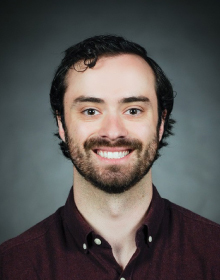The place to be
Through his research and his life experience, local grad student Colin Connors is proving that when it comes to memory formation—and life—being in the right place matters.
Where are you from?
I’m very proud to have been born and raised right here in St. John’s. If I had to choose one favourite place, it would have to be the Torbay point lookout on the Cobbler’s Path section of the East Coast Trail—the view is astounding.
What do you enjoy doing for fun?
I love hiking, which makes Newfoundland and Labrador a perfect place for me to live. I also love watching basketball, discovering new indie music, and playing board games like Catan.
Why did you decide to pursue a graduate degree?
I’ve always loved neuroscience but hadn’t had the opportunity to explore it in a research capacity. A master’s degree offered the perfect way to learn what a career as a neuroscientist looks like.
Why did you choose Memorial University for your graduate studies?
I’m very passionate about living in Newfoundland and Labrador so staying home was certainly a priority. That said, regardless of location, the opportunity to study in Dr. Parsons’ lab was a natural fit. The research topics aligned with my interests, and the lab’s tightknit environment provided an incredibly welcoming space to spend every day.
What is your research/thesis about? How do you describe your research to a general audience with no background in the field?
NMDA receptors (NMDARs) facilitate brain cell communication, but their location within the cell affects their function. NMDARs are predominantly found at the synapse—the point where brain cells interact-- allowing for healthy signaling. However, in pathological states such as Alzheimer’s disease (AD), the balance of NMDARs shifts toward cellular regions outside the synapse, where activation drives cell death and subsequently, cognitive issues.
Memantine is a drug that has been shown to help NMDARs stay anchored at the synapse by strengthening interactions with support proteins. However, it remains unexplored if Memantine restores this balance in AD, especially in the hippocampus-- a brain area vital in memory. Using a well-established AD mouse model that mimics human NMDAR mislocalization, I’m researching whether Memantine shifts the NMDAR distribution back towards synapses.
How would you describe your experience as a graduate student at Memorial?
My experience has been fantastic. Doing research that contributes to such an important cause is something I’m grateful for every day I come to campus.
What scholarships or awards have you received?
I’ve been fortunate to receive the F.A. Aldrich Fellowship, the A.G. Hatcher Memorial Scholarship, the Faculty of Medicine’s Dean’s Fellowship Award, the Canada Graduate Research Scholarship – Master’s (CGRS M) program, and I was nominated by Memorial for the nationwide Mackenzie King Open Scholarship (results pending).
Have you faced any challenges in life that you’ve overcome to pursue graduate studies?
For most of my life, I was a competitive basketball player but unfortunately suffered a career-ending injury before finishing my university eligibility. Prior to that injury, I aspired to play professionally after university, so having my career end early such that I had to pursue graduate studies earlier in my life than anticipated was quite the adjustment.
What advice would you give to current or future graduate students?
Get involved in anything on campus that interests you. I’m an assistant coach with the varsity men’s basketball team and serve as the neuroscience representative on the Medical Graduate Student Society (MGSS). Both roles have helped me make friends on campus and feel like a part of the Memorial community, which has greatly enriched my graduate student experience.
Become a graduate student at Memorial. Apply online today!
